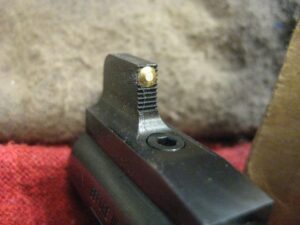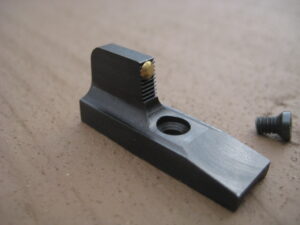
By John Markwell | Contributing editor
Handgun shooters for centuries have been looking for ways to better their aim.
Discounting optical sights, accentuating the front sight has been their main option, from simply making them bigger and bolder, to reflecting light on to them and adding contrasting colors via paint, colored inserts, fiber optic rods and luminescent vials. And then there is the gold bead front sight which has been around for quite some time. The first references to the gold bead we are familiar with is in J. Henry FitzGerald’s Shooting published in 1930 and Elmer Keith’s Sixguns of the same era. Fitz, Keith and several other shooters of that time were big fans of gold bead front sights and often referred to them in their writings. Here’s the story.
There are essentially two types of gold bead front sight inserts. They are found in most front sight profiles, be it a Baughman ramp, Patridge blade, or some variation of either. It should also be noted that some are not gold but brass; more on that later.
Charles Call was a long-term Service Foreman with Smith & Wesson and he came up with the Call Front Sight, probably in the 1930s. From the S&W Centennial Catalog; “This sight is an excellent dual- purpose unit for the target shooter who also carries his gun afield. The flat gold bead mounted flush in the rear surface of the blade can be seen under adverse lighting conditions. On the target range the bead can be smoked over with a match or carbide lamp and the blade reverts to the required Patridge type square post.”
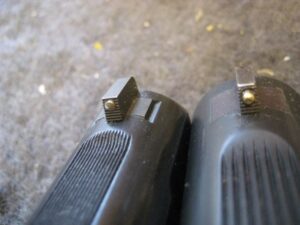
Today’s handgunners refer to any flat-faced gold bead as a Call-type bead whether flush fitted in the front sight blade or not.
The second type of gold bead sight insert is the McGivern style. Again, from the S&W Centennial Catalog; “This is another dual-purpose sight different from the Call design in that the bead is a half sphere of gold which protrudes from the rear face of the Patridge blade. The advantage of the McGivern bead lies in the fact that its globular shape will pick up skylight from practically any angle and reflect it back to the eye of the shooter. Its originator, Ed McGivern, the famous speed and exhibition shooter from Great Falls, Montana, holds this sight to be the best possible for aerial work, or where targets are dark colored and not clearly lighted.”
Smith & Wesson has offered both the Call and McGivern style gold bead sight inserts in either Patridge blade or Baughman ramp style front sights on and off for years. Other aftermarket parts outfits offer bead front sights for revolvers with replaceable front sight blades and others offer gold bead front sights for 1911 pistols with dovetailed front sights. Ironically, most of these sight sellers make no distinction between Call and McGivern styled beads and, quite frankly, most handgunners either don’t know there is a difference or don’t care. There is one well known 1911 semi-custom house that uses both flat faced (Call) and McGivern (domed) beads on their pistols and, unless the customer specifies which is wanted, one gets whichever the smith puts on the gun.
The gold bead front sight is more than just an aid for older eyes or for use on dark targets. They are great for fast sight acquisition on defensive handguns. The most effective diameter seems to be between .080” and .100” in diameter. Regardless of the gun’s purpose, they must be properly installed with the top of the bead even with the top of the front sight as viewed by the shooter. This is often overlooked by many purveyors of these sights. If there is front sight blade material visible above the bead and the hand gun is precisely zeroed to the top of the blade, the bead is below the point of aim.
We have found that at speed, the shooter tends to focus on the bead thus sending shots high. With the top of the bead even with the top of the front sight this is not a problem. In his seminal work Sixguns, Keith states that he prefers a gold bead or bar “across the top face of the front sight” and also has a preference for the flat-faced Call bead. Also, with the top of the gold bead even with the top of the front sight, the bottom of the bead can be used as a hold-over index for shooting at longer ranges by raising it so that the lower, six o’clock point, lines up with the top of the rear sight notch.
There are several variations on the gold bead theme. The Heirloom Precision front sight has a vertical gold line inlayed into the face of the front sight. This is an elegant front sight treatment and a nice cosmetic touch for custom 1911s. The face of the sight body and the gold line are serrated and the blade’s height can be cut down for a very precise zero. We have this front sight on our custom Springfield EMP and although we question its utility it is very cool.
Elmer Keith experimented with several front sight enhancements. One of the most unique was the three-bar blade for long range revolver shooting. This sight had 3 horizontal fine gold lines inlayed into the face of the sight blade to provide hold points for different ranges.
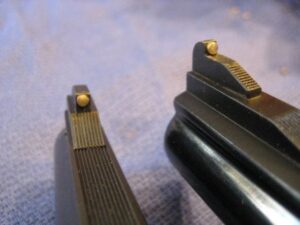
A Google search brought up more references to gold bead type sights than we expected. There are sights for both revolvers and auto loading pistols as well as for shotguns, and iron sighted rifles and carbines. Some are drop-in installations and others require fitting. For autoloading pistols with dovetailed front sights, it is essential that one knows which dovetail their pistol has, be it a Novak, Wilson or other cut.
Revolver sights are available as drop-in units where applicable or for hand fitting, as with older S&W Models. SDM Fabrication has a great assortment of ready-made gold bead sights for a variety of revolvers. For the skilled do-it-your-selfer, just the plain gold bead inserts are available. Ruger single actions with screwed on front sight ramps/blades are great candidates for DIY gold bead front sight upgrades. Georgia Outdoors has a couple of front ramp options with gold beads that look to provide a very fine sight picture.
We have been working on an upgrade of a Ruger Single Six in .32 H&R Mag. and have installed a gold bead ramp front sight from Fermin Garza of Corpus Christi, TX. The bead Fermin uses is brass instead of gold but is unique in that the bead is actually threaded into the sight blade. Fermin does this because many folks use his sights on hard recoiling revolvers that have a reputation for launching pressed or glued in beads into the nether-lands. Fermin’s sights are also done right in that the top of the bead is even with the top of the sight blade. If a gold bead sight is of interest, we highly recommend a Google search; the results will keep you busy for quite some time.
We’ve had gold bead (and a few brass) sights on both revolvers and auto loading pistols for a lot of years. They are more durable than fiber optic and we find them just as fast and easy to use. They even work in low light pretty well and if it’s really dark; well, you should have a flashlight anyway. And, unlike night sights the gold will not “go out.” Unlike gold, the brass beads need a bit of polishing on occasion but other than that these sights are maintenance free. Over the years we’ve only had one gold insert disappear while shooting and the manufacturer (Wilson Combat) quickly replaced the entire sight with just a phone call.
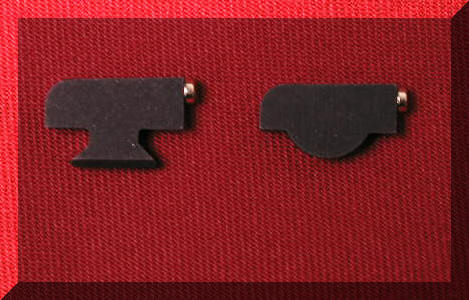
As most readers know, there are a plethora of rear sight blade styles available. The rear sight blade that we’ve come to prefer for use with gold beads has a plain black blade with a U-notch wide enough to allow for plenty of light on either side of the front sight. There are some folks who swear by shallow express type rear sights for use with beads but we have yet to try one. Common on dangerous game rifles, express sights are fast and more accurate than one would think
This is where there is usually a list of suppliers and manufacturers. However, we again suggest searching the web (as much as we hate to). Dialing up gold bead front sights will give you more information that can be digested in one sitting. Be aware though, like many things in the world of the gun; gold bead front sights are addicting; ask me how I know?

